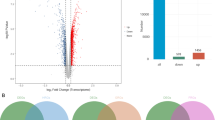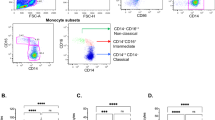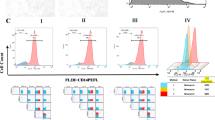Abstract
Study design: In vitro study on the effects of mycophenolate mofetil (MMF) on isolated human monocytes and endothelial cells.
Objectives: Haematogenous macrophages play an essential role in the development of secondary damage following spinal cord injury (SCI), and there is evidence that the use of immunosuppressants such as MMF can reduce monocyte invasion and neuronal damage.
Setting: University Hospital for Orthopaedic Surgery, Frankfurt am Main, Germany.
Methods: The effects of MMF on the adhesion of human monocytes to human umbilical vein endothelial cells (HUVEC), monocyte binding to immobilised E-selectin, and monocyte expression of intercellular adhesion molecule (ICAM)-1, sialyl Lewis X (sLeX) and major histocompatibility complex (MHC)-II were studied. The binding of monocytes to E-selectin was examined by using purified and immobilised E-selectin fusion protein. Adhesion molecule expression was investigated by flow cytometry.
Results: The binding of monocytes to HUVEC was significantly reduced by 30.1% after treatment of monocytes with MMF (10 μg/ml), whereas the pretreatment of HUVEC with MMF did not result in significant changes in monocyte adhesion. MMF forcefully inhibited monocyte binding to immobilised E-selectin by 55.7%. Furthermore, MMF significantly inhibited the upregulation of ICAM-1- and MHC-II-expression on monocytes stimulated with either lipopolysaccharide or interferon-γ, whereas the expression of sLeX was not impaired. Toxic effects were excluded by propidium-iodide staining and measurement of fluorescein-diacetate metabolism.
Conclusion: MMF can downregulate important monocytic adhesion molecules and inhibits monocyte adhesion to endothelial cells, thus indicating that treatment with MMF could be beneficial after SCI.
Sponsorship: This study was supported by the DFG (Ha 2721/1-3), the Paul und Ursula Klein-Stiftung and the Stiftung Friedrichsheim.
Similar content being viewed by others
Log in or create a free account to read this content
Gain free access to this article, as well as selected content from this journal and more on nature.com
or
References
Choi DW . Cerebral hypoxia: some new approaches and unanswered questions. J Neurosci 1990; 10: 2493–2501.
Demopoulus HB, Flamm ES, Pietronigro DD, Seligman ML . The free radical pathology and the microcirculation in the major central nervous system disorders. Acta Physiol Scand 1980; 492: 91–119.
Liu D, Ling X, Wen J, Liu J . The role of reactive nitrogen species in secondary spinal cord injury: formation of nitric oxide, peroxynitrite, and nitrated protein. J Neurochem 2000; 75: 2144–2154.
Liu D, Thangnipon W, McAdoo DJ . Exciatory amino acids rise to toxic levels upon impact injury to the rat spinal cord. Brain Res 1991; 547: 344–348.
Cavaillon JM . Cytokines and macrophages. Biomed Pharmacother 1994; 48: 445–453.
van der Laan LJ et al. Macrophage phagocytosis of myelin in vitro determined by flow cytometry: phagocytosis is mediated by CR3 and induces production of tumor necrosis factor-alpha and nitric oxide. J Neuroimmunol 1996; 70: 145–152.
Blight AR, Cohen TI, Saito K, Heyes MP . Quinolinic acid accumulation and functional deficits following experimental spinal cord injury. Brain 1995; 118: 735–752.
Sinz EH et al. Quinolinic acid is increased in CSF and associated with mortality after traumatic brain injury in humans. J Cereb Blood Flow Metab 1998; 18: 610–615.
Davies SJ et al. Regeneration of adult axons in white matter tracts of the central nervous system. Nature 1997; 390: 680–683.
Fitch MT, Silver J . Activated macrophages and the blood brain barrier: inflammation after CNS injury leads to increases in putative inhibitory molecules. Exp Neurol 1997; 14: 587–603.
de Vries HE et al. Lymphocyte adhesion to brain capillary endothelial cells in vitro. J Neuroimmunal 1994; 52: 1–8.
Mabon PJ, Weaver LC, Dekaban GA . Inhibition of monocyte/macrophage migration to a spinal cord injury site by an antibody to the integrin alphaD: a potential new anti-inflammatory treatment. Exp Neurol 2000; 166: 52–64.
Stanimirovic DB, Wong J, Shapiro A, Durkin JP . Increase in surface expression of ICAM-1, VCAM-1 and E-selectin in human cerebromicrovascular endothelial cells subjected to ischemia-like insults. Acta Neurochir Suppl. (Wien) 1997; 70: 12–16.
Carlos TM et al. Expression of endothelial adhesion molecules and recruitment of neutrophils after traumatic brain injury in rats. J Leukoc Biol 1997; 61: 279–285.
Clark WM, Madden KP, Rothlein R, Zivin JA . Reduction of central nervous system ischemic injury by monoclonal antibody to intercellular adhesion molecule. J Neurosurg 1991; 75: 623–627.
Hamada Y et al. Involvement of an intercellular adhesion molecule 1-dependent pathway in the pathogenesis of secondary changes after spinal cord injury in rats. J Neurochem 1996; 66: 1525–1531.
Farooque M, Isaksson J, Olsson Y . Improved recovery after spinal cord trauma in ICAM-1 and P-selectin knockout mice. Neuroreport 1999; 10: 131–134.
Allison AC, Eugui EM . Immunosuppressive and other effects of mycophenolate acid and an ester prodrug mycophenolate mofetil. Immunol Rev 1993; 136: 5–28.
Allison AC, Eugui EM . Mycophenolate mofetil, a rationally designed immunosuppressive drug. Clin Transplant 1993; 7: 96–112.
Allison AC et al. Mycophenolic acid and brequinar, inhibitors of purine and pyrimidine synthesis, block the glycosylation of adhesion molecules. Transpl Proc 1993; 25: 67–70.
Walz G et al. Recognition by ELAM-1 of the sialyl Lewis X determinant on myeloid and tumor cells. Science 1990; 250: 1332–1335.
Wittig BM et al. α (1,3) Fucosyltransferase expression in E-selectin-mediated binding of gastrointestinal tumor cells. Int J Cancer 1996; 67: 80–85.
Zettlmeissel G et al. Expression and characterisation of human CD4: immunoglobulin fusion protein. DNA Cell Biol 1990; 9: 347–353.
Dusart I, Schwab ME . Secondary cell death and inflammatory reaction after dorsal hemisection of the rat spinal cord. Eur J Neurosci 1994; 6: 712–724.
Holmin S, Mathiesen T, Shetye J, Biberfeld P . Intracerebral inflammatory response to experimental contusion. Acta Neurochir (Wien) 1995; 132: 110–119.
Popovich PG, Wei P, Stokes BT . Cellular inflammatory response after spinal cord injury in Sprague–Dawley and lewis rats. J Comp Neur 1997; 377: 443–464.
Fabry Z, Raine CS, Hart MN . Nervous tissue as an immune compartment: the dialect of the immune response in the CNS. Immunol Today 1994; 15: 218–224.
Hauser SL et al. Immunohistochemical staining of normal human brain with monoclonal antibodies that identify lymphocytes, monocytes, and the la antigen. J Neuroimmunol 1983; 5: 197–205.
Oehmicken M . Inflammatory cells in the central nervous system: an integrated concept based on recent research in pathology, immunology, and forensic medicine. Prog Neuropathol 1983; 5: 277–335.
Navratil E et al. Expression of cell adhesion molecules by microvascular endothelial cells in the cortical and subcortical regions of the normal human brain: an immunohistochemical analysis. Neuropathol Appl Neurobiol 1997; 23: 68–80.
Blight AR . Delayed demyelination and macrophage invasion: a candidate for secondary cell damage in spinal cord injury. CNS Trauma 1985; 2: 299–315.
Blight AR . Effects of silica on the outcome from experimental spinal cord injury: implication of macrophages in secondary tissue damage. Neuroscience 1994; 60: 263–273.
Dijkstra CD, de Groot CJ, Huitinga I . The role of macrophages in demyelination. J Neuroimmunol 1992; 40: 183–188.
Giulian D et al. Reactive mononuclear phagocytes release neurotoxins after ischemic and traumatic injury to the central nervous system. J Neurosci Res 1993; 36: 681–693.
Giulian D, Robertson C . Inhibition of mononuclear phagocytes reduces ischemic injury in the spinal cord. Ann Neurol 1990; 27: 33–42.
Hamada Y et al. Roles of nitric oxide in compression injury of rat spinal cord. Free Radic Biol Med 1996; 20: 1–9.
Lee YB et al. Role of tumor necrosis factor-alpha in neuronal and glial apoptosis after spinal cord injury. Exp Neurol 2000; 166: 190–195.
Schwab JM, Brechtel K, Nguyen TD, Schluesener HJ . Persistent accumulation of cyclooxygenase-1 (COX-1) expressing microglia/macrophages and upregulation by endothelium following spinal cord injury. J Neuroimmunol 2000; 111: 122–130.
Popovich PG et al. Depletion of hematogenous macrophages promote partial hindlimb recovery and neuroanatomical repair after experimental spinal cord injury. Exp Neurol 1999; 158: 351–365.
Canella B, Cross AH, Raine CS . Upregulation and coexpression of adhesion molecules correlate with relapsing autoimmune demyelination in the central nervous system. J Exp Med 1990; 172: 1521–1524.
Isaksson J et al. Expression of ICAM-1 and CD11b after experimental spinal cord injury in rats. J Neurotrauma 1999; 16: 165–173.
Engelhardt B, Vestweber D, Hallmann R, Schulz M . E- and P-selectin are not involved in the recruitment of inflammatory cells across the blood–brain barrier in experimental autoimmune encephalomyelitis. Blood 1997; 90: 4459–4472.
Connolly Jr ES et al. Exacerbation of cerebral injury in mice that express the P-selectin gene: identification of P-selectin blockade as a new target for the treatment of stroke. Circ Res 1997; 81: 304–310.
Okada Y et al. P-selectin and intercellular adhesion molecule-1 expression after focal brain ischemia and reperfusion. Stroke 1994; 25: 202–211.
Zhang RL et al. E-selectin in focal cerebral ischemia and reperfusion in the rat. J Cereb Blood Flow Metab 1996; 16: 1126–1136.
Heeman U et al. Mycophenolate mofetil inhibits lymphocyte binding and the upregulation of adhesion molecules in acute rejection of rat kidney allografts. Transpl Immunol 1996; 4: 64–67.
Laurent AF, Dumont S, Poindron P, Muller CD . Mycophenolic acid suppresses protein N-linked glycosylation in human monocytes and their adhesion to endothelial cells and to some substrates. Exp Hemat 1996; 24: 59–67.
Nowak I, Shaw LM . Mycophenolic acid binding to human serum albumin: characterization and relation to pharmacodynamics. Clin Chem 1995; 41: 1011–1017.
Baer PC et al. Effects of mycophenolic acid on human renal proximal and distal tubular cells in vitro. Nephrol Dial Transplant 2000; 15: 184–190.
Blaheta RA et al. Inhibition of endothelial receptor expression and of T-cell ligand activity by mycophenolate mofetil. Transpl Immunol 1998; 6: 251–259.
Acknowledgements
We thank Ms R Schröder, Ms E Oppermann and Ms N Roser for their excellent technical assistance. This study was supported by the DFG (Ha 2721-/1-3), the Paul und Ursula Klein-Stiftung and the Stiftung Friedrichsheim.
Author information
Authors and Affiliations
Rights and permissions
About this article
Cite this article
Glomsda, B., Blaheta, R. & Hailer, N. Inhibition of monocyte/endothelial cell interactions and monocyte adhesion molecule expression by the immunosuppressant mycophenolate mofetil. Spinal Cord 41, 610–619 (2003). https://doi.org/10.1038/sj.sc.3101512
Published:
Issue date:
DOI: https://doi.org/10.1038/sj.sc.3101512
Keywords
This article is cited by
-
Macrophage lipid accumulation in the presence of immunosuppressive drugs mycophenolate mofetil and cyclosporin A
Inflammation Research (2019)
-
Long-term outcome of mycophenolate mofetil treatment for patients with microscopic polyangiitis: an observational study in Chinese patients
Rheumatology International (2016)
-
In vitro effects of mycophenolic acid on survival, function, and gene expression of pancreatic beta-cells
Acta Diabetologica (2012)



